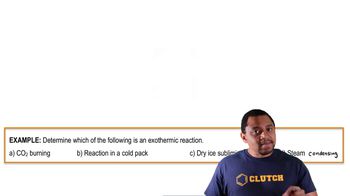Indicate whether each statement is true or false. (a) A reaction that is spontaneous in one direction will be nonspontaneous in the reverse direction under the same reaction conditions. (b) All spontaneous processes are fast. (c) Most spontaneous processes are reversible. (d) An isothermal process is one in which the system loses no heat. (e) The maximum amount of work can be accomplished by an irreversible process rather than a reversible one.
Ch.19 - Chemical Thermodynamics
Chapter 19, Problem 15a
Consider the vaporization of liquid water to steam at a pressure of 1 atm. (a) Is this process endothermic or exothermic?
 Verified step by step guidance
Verified step by step guidance1
Identify the process: Vaporization is the phase transition from liquid to gas.
Recall the energy requirement: Vaporization requires energy input to overcome intermolecular forces.
Determine the type of process: Since energy is absorbed from the surroundings, the process is endothermic.
Consider the system and surroundings: In an endothermic process, the system absorbs heat, causing the surroundings to cool down.
Conclude: The vaporization of liquid water to steam at 1 atm is an endothermic process.

Verified video answer for a similar problem:
This video solution was recommended by our tutors as helpful for the problem above.
Video duration:
3mWas this helpful?
Key Concepts
Here are the essential concepts you must grasp in order to answer the question correctly.
Endothermic and Exothermic Processes
Endothermic processes absorb heat from the surroundings, resulting in a temperature decrease in the environment. In contrast, exothermic processes release heat, causing an increase in the surrounding temperature. Understanding these definitions is crucial for determining the nature of a phase change, such as vaporization.
Recommended video:
Guided course

Endothermic & Exothermic Reactions Example 2
Phase Changes
Phase changes refer to the transitions between different states of matter, such as solid, liquid, and gas. Vaporization, specifically, is the transition from liquid to gas, which requires energy input to overcome intermolecular forces. Recognizing the energy dynamics involved in phase changes helps in identifying whether they are endothermic or exothermic.
Recommended video:
Guided course

Entropy in Phase Changes
Latent Heat of Vaporization
The latent heat of vaporization is the amount of energy required to convert a unit mass of a liquid into vapor without a change in temperature. For water, this process at 1 atm pressure requires significant energy input, indicating that vaporization is an endothermic process. This concept is essential for understanding the energy requirements during phase transitions.
Recommended video:
Guided course

Heat Capacity
Related Practice
Textbook Question
Textbook Question
(d) Does the amount of work that a system can do on its surroundings depend on the path of the process?
2
views
Textbook Question
Consider the vaporization of liquid water to steam at a pressure of 1 atm. (b) In what temperature range is it a spontaneous process?
Textbook Question
Consider the vaporization of liquid water to steam at a pressure of 1 atm. (c) In what temperature range is it a nonspontaneous process?
1
views
Textbook Question
Consider the vaporization of liquid water to steam at a pressure of 1 atm. (d) At what temperature are the two phases in equilibrium?
